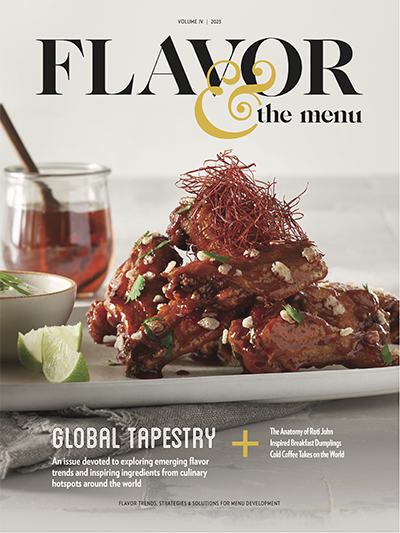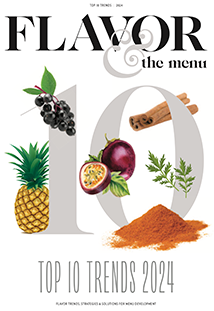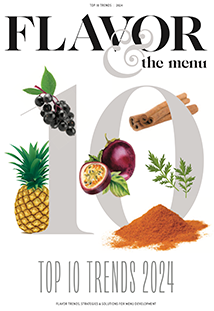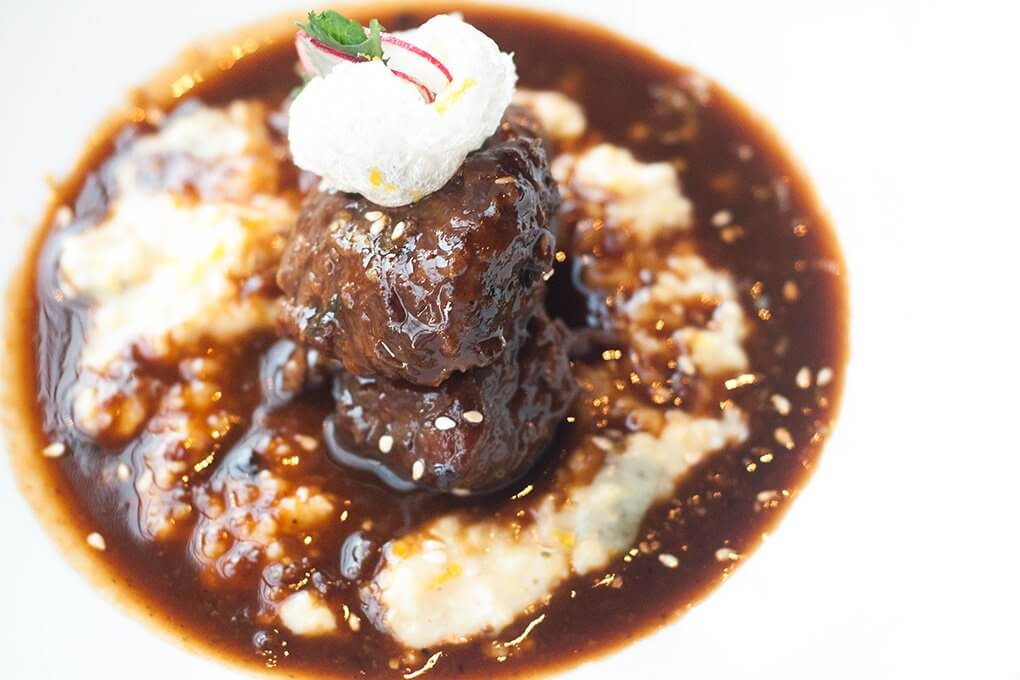Consumers today are steadfast in their love of heat, but are happy to play the field when it comes to which chile peppers deliver that heat. Thrill seeking move them from one to the next, searching for that next zing that makes their hearts sing. Much of this country’s evolution of flavor preferences can be mapped over a course of chile pepper dalliances. The more significant ones mark a culinary timeline of heat, from Buffalo to chipotle to jalapeño to habanero to Sriracha to harissa, with a number of other chile peppers also dotting the path.
Menu developers looking to entice diners with new flavor adventures are always on the lookout for the next chile pepper—the one that will romance their guests with new layers of heat, flavor and intrigue, or the one they can use as a strategy for flavor differentiation. Guajillo is becoming a go-to for chefs. It’s complex, colorful, fruity, sweet, smoky and a little tart. That complexity tees up guajillo nicely, as a lot of diners seem to be trading in scorching heat for a more nuanced flavor experience.
“The chile craze has never really cooled down—it keeps heating up with every new chile feature,” says Rob Corliss, chef and founder of ATE (All Things Epicurean). “Top-of-mind chile varieties will come and go. However, the flavor connection and affinity we have for these chiles is the lasting story. The success of one chile introduction paves the way for the next. Guajillo chiles provide an opportunity to explore, market and menu a new chile variety. Their rustic color and slightly sweet, mild heat are sure to please, as the flavor profile is not polarizing.”
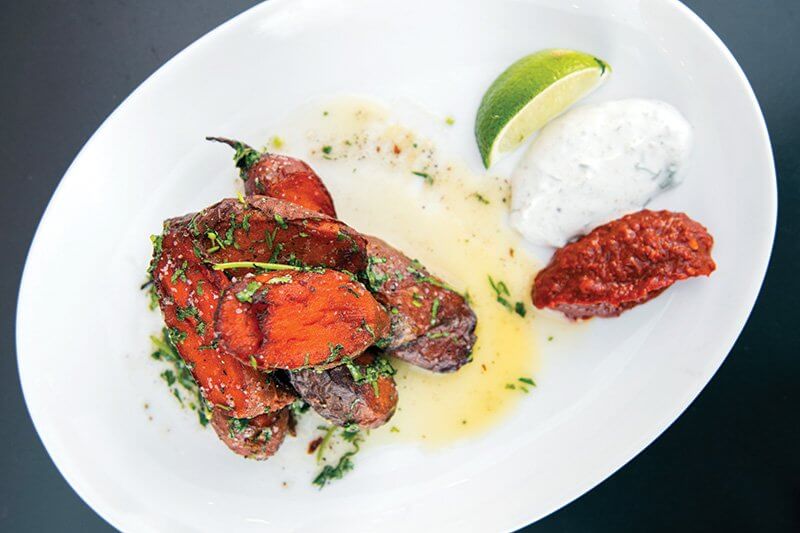
Grilled Pueblo Yams at Mister Tuna in Denver get a flavor boost from guajillo chile paste, served alongside coriander yogurt and lime.
Modern Mexican Momentum
Apart from being thrust into the limelight as the latest star in the constellation of chile pepper profiles, guajillo is making moves thanks to a few other drivers. The deeper exploration of Mexican flavors and ingredients helps advance guajillo. Searching beyond the burrito and taco, chefs here are now highlighting more of the wonders of authentic Mexican flavors and ingredients, from moles and tortas to micheladas and mezcals. The innovation surrounding guajillo menu play is taking a similar path—chefs are hitching it onto modern American dishes, rather than limiting themselves to authentic Mexican fare.
Motto in Durham, N.C., centers a dish of braised pork cheeks, green chile grits and crispy skin in a guajillo broth. At Evil Eye in San Francisco, guajillo chile aïoli accompanies fried cauliflower with Cotija and lemon. And, as with other chiles, it’s even making a play on cocktail menus. At Proof and Provision in Atlanta, the Jacked Rose stars brandy infused with guajillo, mole bitters, pomegranate juice and lemon peel.
Amanda Cohen, chef-owner of Dirt Candy in New York, uses guajillo to add complexity to one of her standout veg-centric dishes, Pepper. “Mexican cooking is incredibly complex and layered, and this is our take on an aguachile, a broth with a lot of depth, that we use to cook haricots coco beans, the tiniest white beans I could find,” says Cohen. The dish stars guajillo chile, red, yellow and orange pepper, Sichuan and ancho, as well as peppercress, along with fresh pepper cut into rings, king oyster mushrooms battered with Sichuan and tempura, cucumber and avocado.
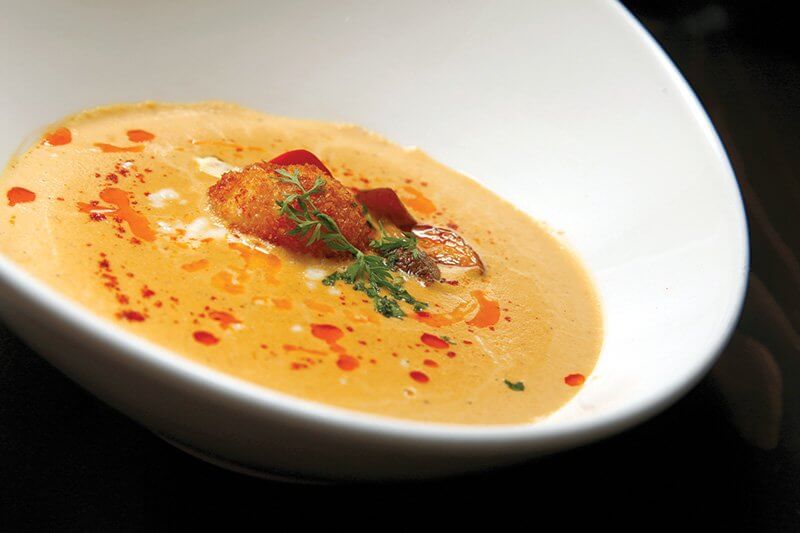
At Madrina in Dallas, Guajillo Corn Chowder is topped with a potato croquette, setas (wild mushrooms), queso fresco and a generous spike of guajillo oil.
Flavor First
The guajillo pepper is a dried chile native to Mexico that offers up a beautiful burnished red hue. In its fresh state, it’s known as the mirasol chile. The guajillo is used widely in Mexican cookery, from moles and broths to sauces and glazes. Rick Bayless has shown its versatility in that universe, featuring it in all of his restaurants. At Xoco in Chicago, he serves a short rib sandwich that stars guajillo-braised short ribs, grilled cactus salad, avocado and black beans.
“In Mexico, guajillo chiles are used in many preparations, both as a background flavor and sometimes as the principle chile expression,” says Chris Koetke, VP of culinary arts for Laureate International Universities. “What is particularly interesting in Mexico is how chiles are used—they are not used simply for the heat factor, but for their flavor. Given America’s love and appreciation for authentic regional Mexican food, this is a natural continuation of this trend.”
Guajillo chiles have a meaty texture with a fruity, smoky flavor, tinged with a medium to low level of heat. “They’re not overly spicy, but they’re beautiful, earthy and tangy, with a nice toasted flavor right at the end,” says Maira Isabel Morales, corporate executive chef and director of R&D for Schlotzsky’s, a fast-casual sandwich concept.
“One of the advantages with guajillo is that they’re dried chiles, which is great at the quick-serve and fast-casual levels.” She likes to use it as a powder, adding it to chocolate for a complex sweet-heat combination. “It’s also transformative sprinkled on grilled chicken, grilled pineapple or mango, maybe in a mango-pineapple sauce over grilled mahi-mahi.”
Farmer’s Almanac in Danville, Calif., calls on the chile for its strip steak, sporting a guajillo and cocoa nib rub, farro salad with kale, roasted carrots, mushrooms and a red wine-cocoa nib vinaigrette.
Guajillo’s depth of flavor is one of the reasons so many chefs are relying on it for flavor-building duty. “Blazing heat was a trend of the past,” says Corliss. “Heat with flavor is the modern day expected point of entry for any chile trend. Discerning consumer palates demand more from menus, and today’s chile introductions are delivering on that sophistication.”
The brunch menu at The Lodge in Laguna Beach, Calif., serves a Pastrami Hash with guajillo chile and dill-pickled green tomatoes. At Elements in Princeton, N.J., sweet and heat match up beautifully in the chocolate ganache with guajillo, pumpkin, paprika and walnut—part of a seasonal tasting menu.
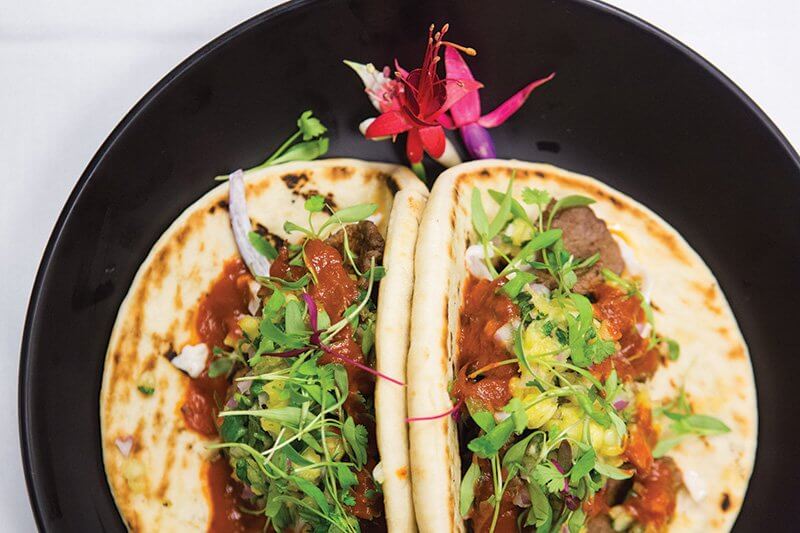
A guajillo-paste marinade adds beautiful color and depth to grass-fed beef, all tucked into pita, finished with Greek yogurt coleslaw, roasted pineapple salsa and a guajillo chile sauce.
Guajillo Demonstrates Depth
Underpinning the flavor story of guajillo is its international charm. Global flavor cues are key in recipe development today, offering diners both adventure and connectivity throughout the menu. Guajillo offers a bridge from familiarity to discovery, comfortably demonstrating consumers’ broad acceptance of global chiles.
“Guajillo chiles provide an element of surprise to any dish,” says Troy Guard, chef-owner of Tag Restaurant Group, based in Denver. “Not only do they add great color, but they also introduce a nice kick of spice—just enough so that you aren’t blowing out your palate.” At his Mexican concept in Denver, Los Chingones, he serves crispy Brussels sprouts with guajillo chiles, Cotija cheese and pasilla-lime. At his New American restaurant, Mister Tuna, he menus Oak-Grilled Pueblo Yams with guajillo, coriander yogurt and lime.
Chef Roberto Santibañez, an authority on Mexican-American cooking, uses guajillo in many applications in his Fonda restaurants in New York, including blended into a burger—a recipe inspired by the pachola burgers from Guanajuato, Mexico. “We grind the chiles guajillos with the beef when raw,” he says. “When the guajillo chars with the grill flames, it imparts the most delicious flavor.” The burger is topped with avocado and pickled red onions and served with sweet potato fries and pasilla de Oaxaca salsa.
Madrina in Dallas offers another example of how this trend is moving guajillo into modern American menu development and bringing in global flair. David Fingerman, executive chef, serves a Guajillo Corn Chowder, topped with setas, potato croquette, queso fresco and guajillo oil. The Guajillo Pork Banh Mi at the Spotted Monkey in Chicago demonstrates a flawless global mash-up, with pork butt braised in guajillo chiles, topped with kimchi and Serrano aïoli. At Three Degrees in Portland, Ore., Lauro Romero, executive chef, serves lamb ribs with guajillo sauce, pomegranate seeds and baby turnips.
Guajillo’s complexity and mid- to low-level heat factor makes it a versatile pantry item. “Fueling this trend is flavor,” says Dave Woolley, chef-owner of CD Culinary Approach culinary consultancy. “Versatility comes through with its toasty, sweet and earthy tones, as well as its availability in foodservice. I see opportunity with guajillo as a shake-on spice rub, blended with classical sauces like demi, hollandaise and beurre blanc to take them into another realm, in braised meats like a guajillo au jus with a Southwest-style French dip, in Mexican hot chocolate, barbecue rubs or sauces—there are so many ways to use it.”
Flavor differentiation and global cues are two crucial drivers in menu development today—from bar bites and beverages to shareables and desserts. Guajillo holds the key to unlocking a number of consumer drivers. “Americans continue to love heat in their food,” says Koetke. “Working with guajillo gives operators an opportunity to provide the heat and rich dried-chile flavor in a way that can capture the patron’s curiosity. It can help drive business through innovation.”
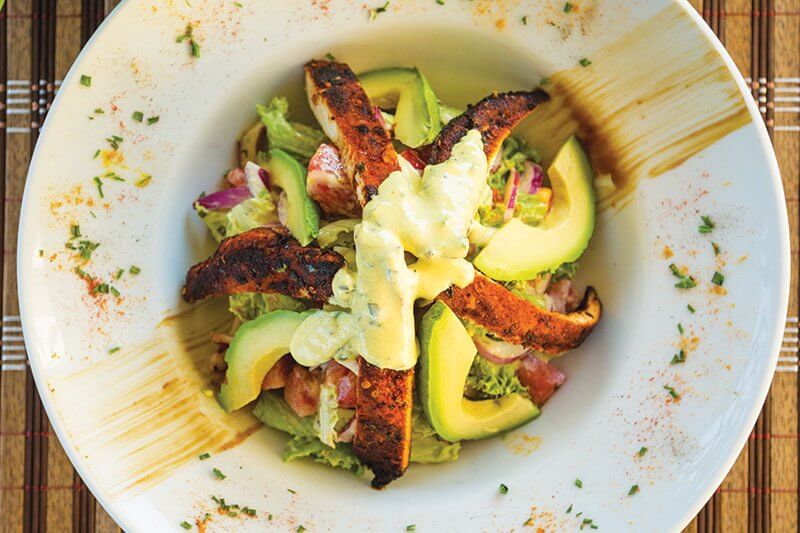
Guajillo is a fantastic flavor builder, adding smoky, fruity complexity with a bit of a bite to marinades,
glazes and sauces.
Guajillo: Forms & Features
By Rob Corliss
Highlighting Mexican flavors and ingredients is a safe play, but guajillo chiles could be showcased with other on-trend global cuisines or in unexpected ways as well. Using paste and powder forms, here are ideas for noteworthy menu features:
Guajillo chile paste
- Blend into a compound butter and use as a flavor topping on meats or seafood, or melt and use as a basting glaze. Whip and use as a signature flavor for your bread service.
- Stir into soup for color and a subtle kick.
- Mix with honey, garlic, orange and cilantro, then toss with crispy chicken bites.
- Stir into beans, rice or potatoes.
- Blend into a salsa or salad dressing.
- Mix with oil and citrus and use as a marinade for meat or seafood.
- Stir into a simmering sauce for meatballs.
- Add a touch to a cocktail for an unexpected yet craveable kick.
Guajillo chile powder
- Blend with sea salt and proprietary seasonings and shake over fries, burgers, eggs, starches, fruits, beverages and more.
Create a signature chile blend
- Guajillo-ancho-pasilla
- Guajillo-chipotle
- Guajillo-Hatch

